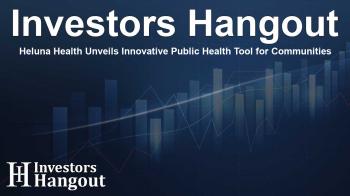Heluna Health Unveils Innovative Public Health Tool for Communities

Heluna Health Unveils Game-Changing Public Health Tool
Heluna Health has introduced an innovative tool called the Local Public Health Resources Index (LPHRI), aimed at providing local health departments with crucial insights into their resources. This index is particularly helpful in enhancing the ability to respond effectively to public health emergencies.
Understanding the Local Public Health Resources Index
The LPHRI serves as a comprehensive database that measures and compares public health resources at the community level. Developed by Heluna Health's Center for Outbreak Preparedness Insights, the index focuses on several key aspects of local health readiness.
The Importance of Local Preparedness
Local health departments play a vital role in managing public health crises. They are frequently the first responders to outbreaks, making it essential for them to have adequate resources. The LPHRI provides a systematic approach to assess and address the varying resource levels among different counties.
Key Findings from the LPHRI
The 2024 index reveals significant variations in public health expenditures among local health departments across regions. For instance, health departments in California are reported to have higher per capita expenditures compared to those in nearby states, showing a striking difference in how resources are allocated.
Insights on Resource Distribution
Jo Kay Ghosh, the director of research and evaluation at Heluna Health, noted that this index emphasizes the necessity for localized data. Understanding these expenditures can inform better resource allocation and planning.
Four Key Domains of Assessment
The index assesses local health preparedness based on four main domains: the public health workforce, clinical lab and pharmacy workforce, public health expenditures, and the adoption of wastewater surveillance technologies. Each area is essential for a robust public health infrastructure.
Workforce Analysis
Findings indicate that jurisdictions with smaller populations tend to have more robust public health staffing levels, while larger populations face staffing challenges. For example, California exhibits the lowest levels of epidemiology professionals but ranks high in local nursing staff, showcasing a unique disparity within the public health workforce.
Technological Adoption in Public Health
The implementation of wastewater surveillance technologies has been inconsistent. While some counties actively utilize these technologies to detect early signs of disease, others have not yet begun testing, indicating a need for increased awareness and adoption of advanced public health tools.
Data Accessibility for Community Leaders
Ghosh highlights that the LPHRI empowers public health officials by offering comparative data that can aid in emergency planning and response strategies. By facilitating access to critical indicators, the index enables health leaders to make data-driven decisions to enhance community health outcomes.
Methodological Transparency
Heluna Health's approach to creating the LPHRI is grounded in data collected from publicly available sources, ensuring transparency and reliability. Users can access detailed county-level data along with technical notes explaining the methodology behind the index.
Engagement with Communities
Blayne Cutler, MD, PhD, president and CEO of Heluna Health, emphasizes the role of the LPHRI in fostering collaboration among communities. The index not only provides an understanding of local health resources but also highlights gaps that can be addressed through joint efforts.
Conclusion: A Step Towards Enhanced Health Security
The launch of the LPHRI represents a significant advancement for local public health officials. By shedding light on resource disparities and encouraging data-driven decision-making, Heluna Health is committed to enhancing public health preparedness across communities.
Frequently Asked Questions
What is the Local Public Health Resources Index?
The LPHRI is a tool developed by Heluna Health to assess and compare public health resources at the local level, providing essential insights for better preparedness.
Who developed the LPHRI?
The Local Public Health Resources Index was developed by Heluna Health's Center for Outbreak Preparedness Insights.
How can local health departments use the LPHRI?
Local health departments can utilize the index to understand their resource levels compared to neighboring jurisdictions, assisting in emergency planning and response.
What areas does the LPHRI focus on?
The index focuses on the public health workforce, clinical lab and pharmacy workforce, public health expenditures, and wastewater surveillance technologies.
Is the LPHRI data publicly accessible?
Yes, the LPHRI provides publicly accessible county-level data along with methodology notes for transparency.
About Investors Hangout
Investors Hangout is a leading online stock forum for financial discussion and learning, offering a wide range of free tools and resources. It draws in traders of all levels, who exchange market knowledge, investigate trading tactics, and keep an eye on industry developments in real time. Featuring financial articles, stock message boards, quotes, charts, company profiles, and live news updates. Through cooperative learning and a wealth of informational resources, it helps users from novices creating their first portfolios to experts honing their techniques. Join Investors Hangout today: https://investorshangout.com/
Disclaimer: The content of this article is solely for general informational purposes only; it does not represent legal, financial, or investment advice. Investors Hangout does not offer financial advice; the author is not a licensed financial advisor. Consult a qualified advisor before making any financial or investment decisions based on this article. The author's interpretation of publicly available data shapes the opinions presented here; as a result, they should not be taken as advice to purchase, sell, or hold any securities mentioned or any other investments. The author does not guarantee the accuracy, completeness, or timeliness of any material, providing it "as is." Information and market conditions may change; past performance is not indicative of future outcomes. If any of the material offered here is inaccurate, please contact us for corrections.
